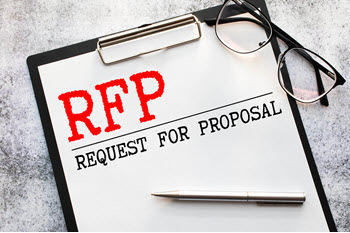
You have a huge project and need help. So, you pull together a Request for Proposal to gather competitive bids. What comes back is less than stellar responses.
What went wrong?
The following explores missteps that sabotage how you create an RFP and what you can do to obtain better results. There are examples for each tip and how small businesses can use those tips for their “not-so-formal” RFP process.
Table of Contents
Defining a Request for Proposal
The prior post, Simple Response Guide to a Request for Proposal, explained what an RFP is. In case you missed it, check out the illustration below.
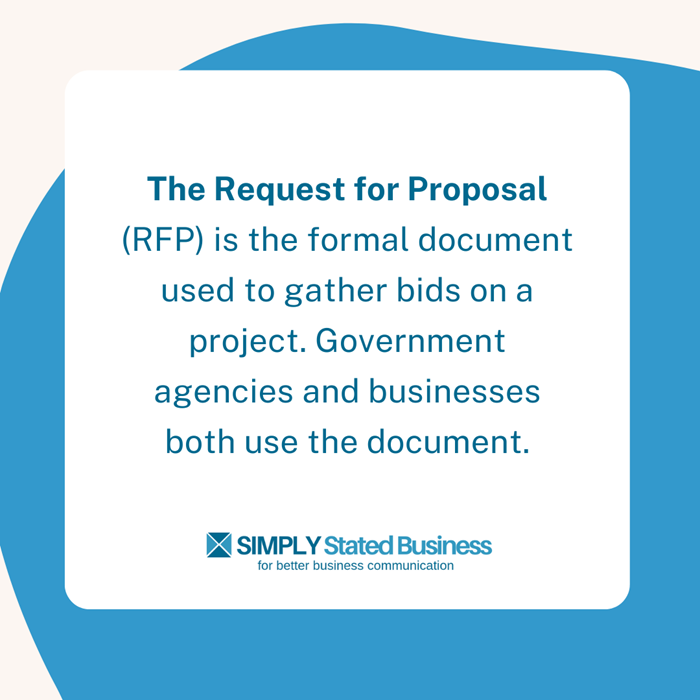
Before you dismiss the document as something you never use, answer the following question.
Do you ever have a need to compare products, services, and prices?
Most of us do, right? So, even if you never have a need for a formal RFP, the following steps can help you in your next purchasing decision. To make life simpler, the post differentiates between the formal RFP and the not-so-formal version.
The Benefits of a Better Request for Proposal
Remember Jennifer from the prior post? She was excited that Martens Products posted an RFP for a new project. But Jennifer had never completed an RFP before. So, she was a bit nervous. Check out her story below.
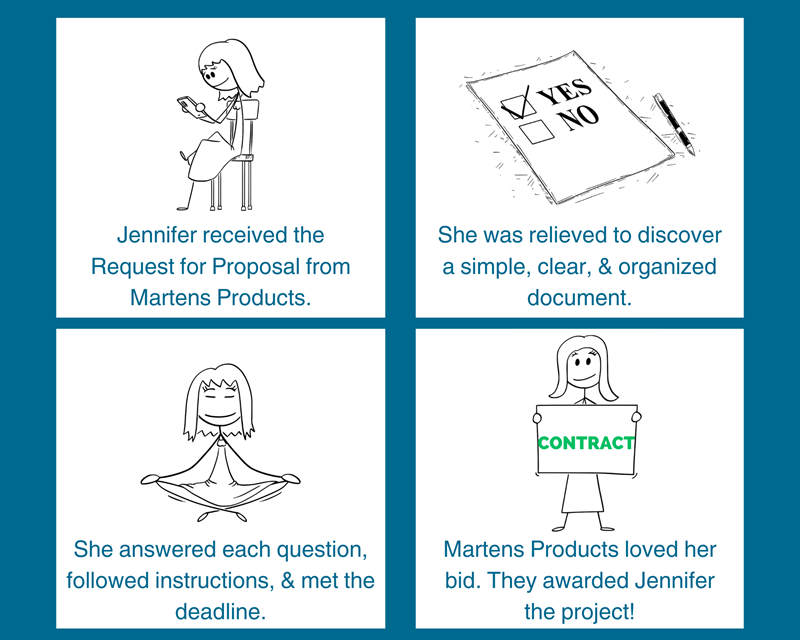
As discussed in the prior post, the RFP process is labor-intensive – for the RFP creator AND the responder. The benefit of a well-written and organized Request for Proposal is simple.
A better Request for Proposal produces a better decision-making tool.
The responders can do a better job when the document is simple and clear. As a result, you get the high-quality information you need to compare bids. That helps you choose the best vendor for your needs.
The following shares 5 Tips for creating a better RFP.
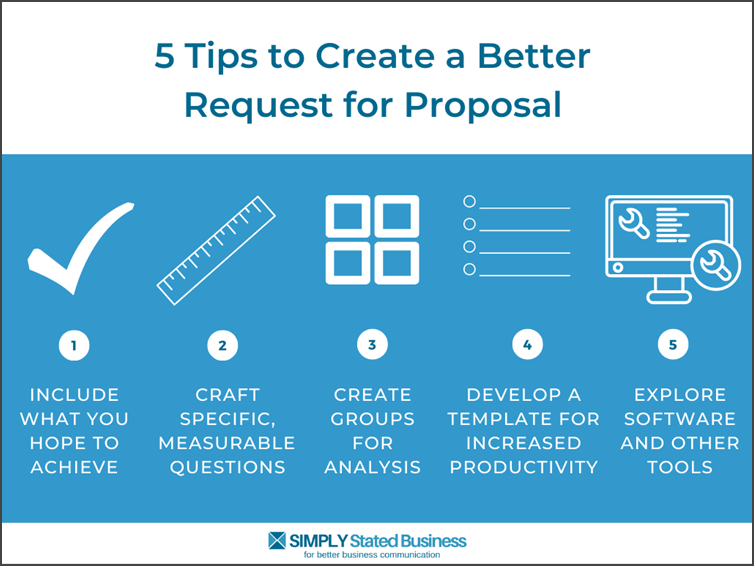
For a Better Request for Proposal
1. Include what you hope to achieve.
Those who create a Request for Proposal often write an introduction or overview. In that section, companies include the following.
- Company background information
- Project details, including deadlines
- Contact information
But you know what is often missing? Project goals and what the business hopes to achieve with the project. That’s like having a discussion with your dog when you frustratingly ask, “What is it you want?”
What you hope to achieve shouldn’t be a secret or a guessing game. You want vendors to succeed, right? When they win, you win. So, let them know what you hope for.
Example of Project Goal
Using our above example, Martens Products created a Request for Proposal for a redesign of its website. In its proposal, Martens Products shared the following purpose.
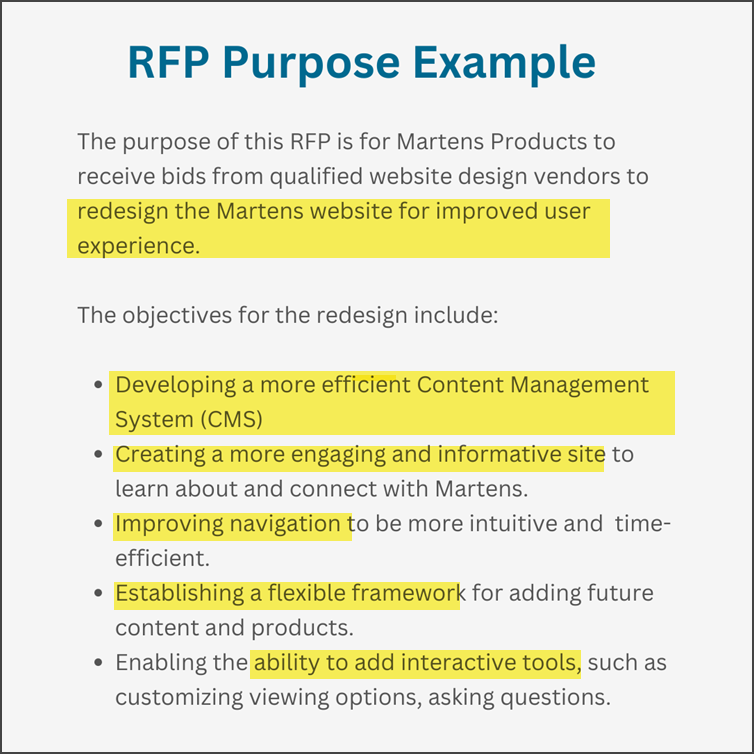
The purpose of the RFP is found at the beginning of the document. You should offer an overview, then provide more detail. In this case, explain what’s working and not working with the current design.
For the Not-So-Formal RFP
Small business owners frequently compare what vendors have to offer. Even if you do not create a Request for Proposal, these tips can help.
If you’re making a purchasing decision, think about the purpose for your purchase.
- If looking to replace or enhance, what’s working for you now? What’s not working?
- What features are important to you?
- Is price a deal-breaker or are you willing to spend a bit more for the right product?
2. Craft specific, measurable questions.
Picture that RFP for the redesign of the Martens Products website. What kind of responses do you think they would receive if they asked the following?
What security measures do you take when building a website?
Talk about an open-ended question. Martens could expect long, rambling responses that may or may not cover the areas Martens is looking for.
Instead, craft questions that you can measure. Be specific.
Example of Specific Questions
- Do your services include monitoring of themes, modules, plugins, and other functional components? If so, describe your process including monitoring frequency and steps taken to fix security holes.
- Are security patches applied within 24 hours?
When you have specific questions, you are better able to quantify responses. For example, you could credit 5 points for each affirmative response to the above questions.
The descriptions are more subjective and should be reviewed by a subject matter expert (SME) – which I am definitely NOT when it comes to site security. 🙂 Your SME should quantify responses wherever possible. Work with them to develop specific questions.
For the Not-So-Formal RFP
A few cars ago, I did extensive research before purchasing my vehicle. I compared specific features, such as mileage, Kelley Blue Book, and model reviews. Then I went out and bought a vehicle because I thought it was cute. Although I loved the vehicle, I would not recommend that approach. 🙂
Even when you do not use a formal RFP for a purchase, think about the specific features you want in a product. I’m a list-maker so I jot them down. That may not be your thing but do think about the specifics.

3. Create groups for analysis.
Do you love working on a 1,000-piece puzzle? While each person has their own method, most sort the individual pieces into some kind of group.
So, when you create a Request for Proposal, picture that giant puzzle. What makes the best sense for grouping your questions together? By grouping your questions, you also make it easier to compare and rate responses.
Example of Groups
Sticking with Martens products, below is an example of what categories the company could use to group questions.
- Design
- Navigation
- Interactive tools
- Content Management System
- Security and maintenance
- Application testing
- Timeline
- Support tools
The above list are broad topics. You may need to be more specific, based on your company’s needs.
For the Not-So-Formal RFP
Similar to thinking about specific questions, developing groups or categories helps you identify what’s important and avoid skipping crucial decision-making points. In fact, you may want to think about the groups or categories first.
For example, if you need to purchase a new computer for your solo business, the following may be good categories.
- Price
- Desktop versus laptop
- Brand
- Processor
- RAM
- Hard Drive
- Graphics
- Operating System
4. Develop a template for increased productivity.
Although the following quote may be incorrectly attributed to Einstein, it fits.
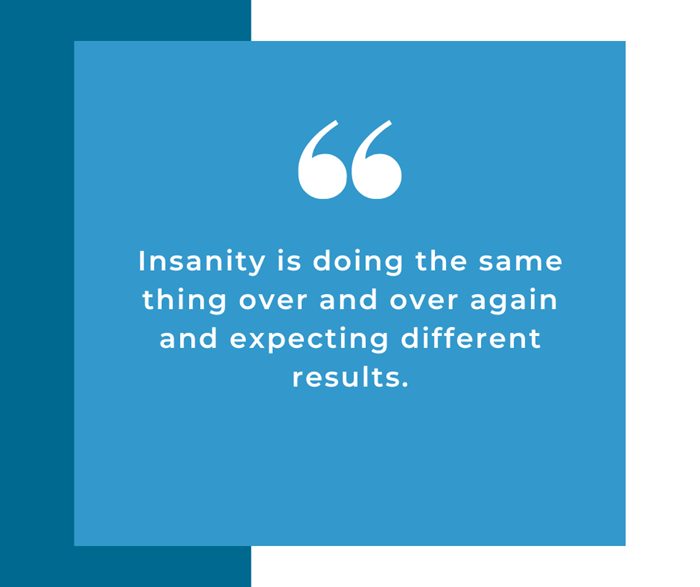
Long, long ago, at the start of this post, the responses received for the fictional RFP were subpar. Although the vendors could be the problem, the quality of the RFP document could be the culprit.
By refining the RFP and creating a template, you improve the process and the results.
Numerous sites offer RFP templates for download. The great thing is you can find industry-specific templates. The following are a few examples.
- Hubspot’s How to Write a Request for Proposal with Template and Sample
- TemplateLab’s 40+ Best Request for Proposal Templates & Examples
- RFP360’s 33 of the best RFP examples: Explore sample RFPs by industry
For the Not-So-Formal RFP
Because I like simple and helping the small business owner, I created a Request for Proposal template. You can download if for free with no strings attached.
So, even if you do not use a formal RFP process, the template is a guide for identifying your purpose, questions, and groups for analysis for purchasing decisions.
TIP: Templates are a place to start. Avoid the “copy and paste” trap.
5. Explore software and other tools.
To create a better Request for Proposal is a massive undertaking. Fortunately, you have multiple tools to choose from.
- Proposal templates (such as those shown above)
- RFP software to automate and manage responses
- RFP management and consulting firms (do a search for “RFP consulting services”)
For the Not-So-Formal RFP
If you are a small business owner, helpful tools do the time-consuming research for you. For example, look for credible review sites that rate and compare vendors, products, and services, such as the following.
When searching for a review site, be specific as possible (e.g., “Reviews of best laptops in 2023”).
Creating a Better Result
Whether you work for a mega-size company or fly solo, making the best purchasing decisions takes thought. It starts with doing your homework.
A formal or not-so-formal Request for Proposal offers a great framework for comparing vendors. For the best results, try the following 5 tips.
- Share what you hope to achieve with your purchase.
- Create specific and measurable questions for vendors to respond to.
- Group your questions into categories for easier reading and analysis.
- Develop templates to streamline the process.
- Explore software and other tools that can help.
How about you? Do you create RFPs? What tips do you have? Share your thoughts in Comments.
Credit: BigStock Photo
Credit: Canva Credit
==================================
Helping you keep your business communication simple, clear, and uniquely yours.
==================================

0 Comments